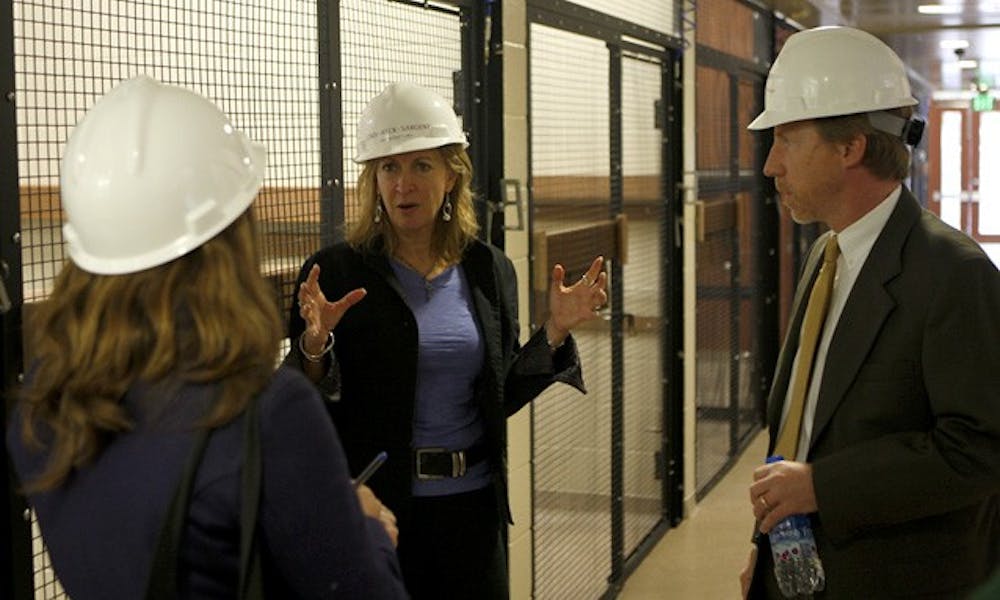Winter is a dark time for Duke’s lemurs.
In spring and summer, many of them are free to explore the Duke Forest as they please. But after Oct. 15, when the skies turn gray and the frost sets in, the lemurs are corralled into cages pumped with warm air to wait out the cold for six months.
After the holiday season, 60 of the University’s 200 lemurs will move into a $3.2 million, 7,000 sq.-ft. Duke Lemur Center facility surrounded by 10,000 square feet of grounds where they will be able to roam free year-round. The building will receive a silver Leadership in Energy and Environmental Design certification from the U.S. Green Building Council.
More lemurs live on Duke’s grounds than anywhere else in the world outside of their native Madagascar, but the opening of the new facility is the first major expansion the Duke Lemur Center has undergone in 40 years, Director Anne Yoder said.
“This is a very exciting day for us,” Yoder, who is also a professor of biology and biological anthropology and anatomy, said before a tour of the new building Wednesday. “It’s a big step forward for us and we are delighted with the product.”
Since Colony Manager Andrea Katz started as a work-study student at the center in 1975, the facilities had remained essentially unchanged until now, she said.
A second building housing 80 lemurs will open Jan. 15, affording some of its residents a semi free-range lifestyle. The $8.2 million bill for both facilities has been covered entirely by the University. The Lemur Center expansions are the last projects administrators approved before announcing an indefinite moratorium on debt-financing construction last Fall, Yoder said.
“I think everybody’s pinching themselves,” she said. “We got in under the wire.... I am extremely grateful to Duke University.”
Lemur Center administrators were forced to scale back the second building by eliminating a wing due to increased construction costs, Katz said. The wing would have housed 20 more primates. But the University has honored the plans it made to finance the center’s expansions before the economy plummeted.
Its commitment to the center has not always been so resolute.
“There was a dark period in our history when the University rightfully asked, ‘Why are we supporting all these exotic animals?’” Yoder said.
In 2001, Provost Peter Lange launched an initiative to evaluate the worth of the center after a review conducted by Vice Provost for Research Jim Siedow found it was neglecting research in favor of conservation goals.
“We certainly recognize that the primate center is an attractive place where schoolchildren and others can learn, but Duke does not have a zoological mission in and of itself,” Lange told Duke Magazine in 2001. “Rather, our core missions are research and teaching. Our service to society is linked through those missions, and all of our facilities need to make a substantial contribution to teaching and to advanced research.”
Lange could not immediately be reached for comment Wednesday evening.
Administrators decided not to close the center in 2004 after dozens of outside experts affirmed that the facility is central to the scientific community’s understanding of primates, Yoder said.
In 2002, then-director William Hylander penned a master plan for the center to bolster its contributions to Duke’s mission of research and teaching, Lange told Duke Magazine.
The two new buildings were called for in the first stage of the plan. Future phases call for a new research facility, another “releasable” building to house the rest of Duke’s primates and a center for visitors and conferences, Yoder said.
Although realizing the entire plan will cost tens of millions of dollars, the Lemur Center is already plotting its next move. Administrators submitted an $8.9 million proposal to the National Institutes of Health to construct a new space for veterinary services and research with stimulus funds, Yoder said.
“The point of this growth is we want to move forward on all three prongs of our mission: research, conservation, education,” she said.
She added that many Duke students conduct non-invasive research with the primates.
“After studies, the lemur goes back to his family group, has a glass of wine, ends the day,” Yoder said. “We do no harm to the lemurs.”
On a guided tour of the completed building, spaces for lemur families included displays of stuffed animals dangling from faux trees to paint a picture of how the primates will inhabit their new homes. Staff members will not have to imagine for much longer.
Temperatures in Durham increased last week, but the lemurs could not enjoy it because they had already been sealed in their cages for winter, Katz said. Each family space in the new facility includes a trap door that swings open to the outside world. From now on, whenever Durham is blessed with warm weather, trainers will be able to let the lemurs out to play.
Taking advantage of a mild morning outdoors, Limerick, a baby ring-tailed lemur, and his twin, Hibernia, ran forward with their arms outstretched, wrestled in a mound of leaves and buried their snouts in the ground. When he remembered the visitors’ presence, Limerick put his games on pause and sat on his haunches with his tail curled high over his head, gazing quizzically up at Katz.
“It’s hard for humans to define happiness in another species,” Katz said. “But they have to be happier like this.”
Get The Chronicle straight to your inbox
Signup for our weekly newsletter. Cancel at any time.

